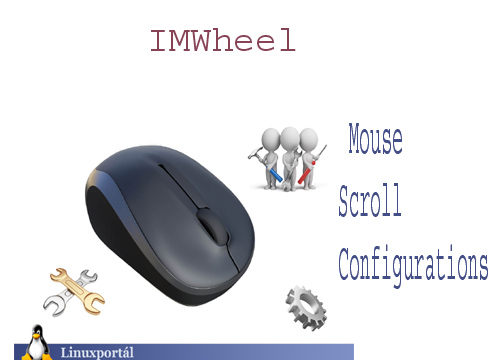IMWheel is a versatile tool used to modify mouse and touchpad button actions, scrolling speeds, and mappings in Linux environments, particularly valuable for adjusting non-standard scroll behavior. This article delves into what IMWheel is, its configurations, and how it can be fine-tuned across various environments, such as Fedora, Wayland, and even with multi-device setups involving virtual machines. Here’s everything you need to know about IMWheel and related mouse configurations.
1. What is an IMWheel?
IMWheel (Improved Mouse Wheel) is a Linux utility that remaps mouse and touchpad buttons and adjusts scrolling speeds. It’s especially helpful for users who require customized scroll settings for different applications or prefer a faster or slower scroll speed than the default.2. What Does the Scroll Wheel Do?
The scroll wheel, generally found between the left and right mouse buttons, allows users to navigate vertically within documents, web pages, and other scrollable content. In many applications, it also enables zooming or custom functions based on software support.3. How to Check Mouse Scroll Settings
To check and adjust mouse scroll settings, users can go to their system settings under the Mouse and Touchpad section in most operating systems. In Windows, for instance, scroll settings are available under Settings > Devices > Mouse. For Linux, IMWheel provides more advanced scroll customization options through its configuration files.4. What is the Scroll Function on a Mouse?
The scroll function on a mouse enables users to navigate up and down in documents, web pages, and other scrollable areas. Some mice also support horizontal scrolling or customizable button mappings, which can be set using utilities like IMWheel for enhanced functionality.Configuring IMWheel: A Step-by-Step Guide
IMWheel offers detailed control over mouse behavior in Linux systems, especially useful in setups with specialized requirements, such as virtual machines or unique input devices. Here’s how to get started with IMWheel configuration.5. IMWheel Configuration (imwheel config)
IMWheel’s configurations are managed through a configuration file, typically located at~/.imwheelrc. Here’s how to configure basic scroll speed and button mappings:
- Open the Config File: Open the
~/.imwheelrcfile with a text editor. - Set Scroll Speed: Use parameters like
UpandDownto adjust scrolling speeds. - Save Changes and Apply: After modifying the file, restart IMWheel using the command
imwheel -b "4 5"to apply the new settings.
6. IMWheel on Fedora (imwheel fedora)
To install and run IMWheel on Fedora:- Install IMWheel: Open a terminal and use the command
sudo dnf install imwheel. - Configure IMWheel: Create and modify the
~/.imwheelrcfile for your preferences. - Run IMWheel on Startup: To make IMWheel run on startup, add it to your startup applications or include
imwheel -b "4 5"in your session manager.
7. IMWheel GUI (imwheel gui)
For those who prefer a graphical interface, IMWheel GUI front-ends are available. The GUI makes it easier to adjust settings without editing configuration files manually, allowing users to set scroll speed and button remapping visually.8. IMWheel with Touchpad (imwheel touchpad)
IMWheel can be used with touchpads to adjust scrolling sensitivity and button mappings:- Configuration: Modify the
~/.imwheelrcfile to tune sensitivity for touchpad scrolling. - Apply Settings: Run
imwheel -b "4 5"to apply changes.
9. IMWheel GitHub Repository (imwheel github)
For advanced users and developers, the IMWheel source code and latest releases are available on GitHub. This allows users to contribute to the tool, report issues, and access community-driven enhancements.10. IMWheel on Wayland (imwheel wayland)
While IMWheel is primarily designed for X11, there are some workarounds to use it on Wayland:- Compatibility Layer: Install
xwaylandto use IMWheel in Wayland sessions. - Alternative Tools: Some users may need to use Wayland-specific tools for complete functionality, as Wayland’s architecture differs from X11 in input handling.
11. IMWheel Back Button Configuration (imwheel back button)
The IMWheel configuration file can be modified to map mouse buttons like the back button to perform different actions:- Edit the Config: Add button mappings in
~/.imwheelrc. - Example Mapping:
None, Thumb1, Alt_L|Leftmaps the back button to perform a “back” browser action.
12. IMWheel Scroll Speed (imwheel scroll speed)
To increase or decrease the scroll speed in IMWheel:- Set Speed in Config File: Edit the
UpandDownoptions in~/.imwheelrc. - Apply Changes: Run
imwheel -b "4 5"to enable new scroll speed settings.
13. Downloading IMWheel (imwheel download)
To download and install IMWheel on various Linux distributions:- Ubuntu:
sudo apt install imwheel - Fedora:
sudo dnf install imwheel - Arch Linux: Use the
yay -S imwheelcommand if using an Arch-based system.
Using IMWheel in Virtualized Environments
VirtualBox and VMware Mouse Configuration
In setups where users have a Windows 10 host and an Ubuntu 20.04 guest, managing multiple mice can be tricky. When using IMWheel in virtual machines, you may need to adjust settings in both the host (Windows) and guest (Ubuntu) to ensure smooth interaction. For example, one mouse may control the host OS while another operates the guest OS. This setup allows more flexibility:- Separate Scroll Configurations: Use IMWheel on the guest OS (Ubuntu) to set specific scroll speeds or button mappings independently of the host settings.
- VirtualBox and VMware Settings: In VirtualBox, ensure that USB support is enabled for direct guest mouse control. In VMware, opt for the “not optimized for gaming” mouse setting to avoid conflicts in mouse movement and scrolling.
